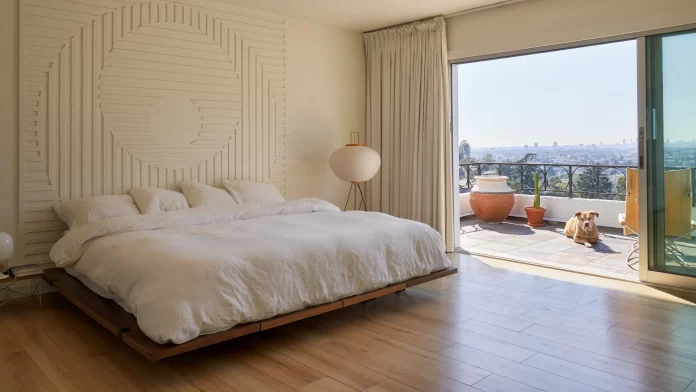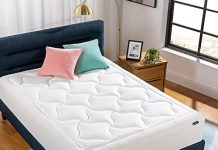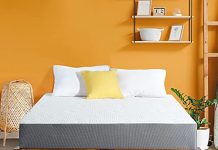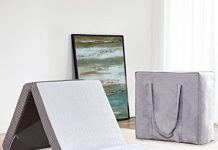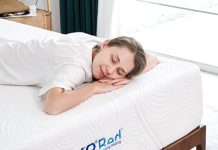In our article, “What Kind Of Bedding And Sheets Work Best With A Floor Mattress?” we will explore the essential tips and tricks to ensure a comfortable and stylish sleeping experience on a floor mattress.
From choosing the right type of bedding to selecting the perfect sheets that complement your floor mattress, we’ve got you covered. Whether you’re looking for a cozy and warm feel or a minimalist and modern aesthetic, we will guide you towards the bedding and sheets that work best for a floor mattress. Get ready for a good night’s sleep with our expert recommendations!
Review contents
Factors to Consider
Size of the floor mattress
One of the most important factors to consider when choosing bedding for a floor mattress is the size of the mattress itself. Floor mattresses come in various dimensions, so it is crucial to measure your mattress accurately to ensure the bedding fits perfectly. Whether you have a twin, full, queen, or king-size floor mattress, choosing the right bedding size will make your bed look aesthetically pleasing and provide a comfortable sleeping surface.
Sleeping position and preferences
Another factor to consider is your sleeping position and preferences. Different individuals have different sleeping styles, whether it be back, side, or stomach sleeping. Some prefer a firm mattress, while others enjoy a plush and soft feel. Understanding your personal preferences will help you choose the right bedding that will complement your sleep needs and provide the necessary support and comfort throughout the night.
Climate and temperature in the bedroom
The climate and temperature in your bedroom should also be considered when selecting bedding for your floor mattress. If you live in a warmer climate or get hot at night, choosing breathable and moisture-wicking materials like cotton or bamboo can help regulate your body temperature and prevent overheating. On the other hand, if you live in a colder climate or prefer a cozier sleep environment, materials like flannel or silk can provide additional warmth and insulation.
Material and comfort level
Lastly, consider the material and comfort level of the bedding. The material plays a vital role in determining the overall feel and durability of your bedding. Common bedding materials include cotton, jersey, microfiber, bamboo, flannel, silk, and linen. Each material has unique characteristics, such as softness, breathability, and moisture-wicking properties. Additionally, consider whether you prefer a softer or firmer feel regarding bedding comfort. Some enjoy the plushness of a down comforter, while others prefer a quilt or blanket’s lightweight and breathable nature.
Bedding Options
Mattress toppers
Mattress toppers are an excellent option if you want to enhance the comfort of your floor mattress. These thick layers of padding can provide additional cushioning and support, helping to alleviate pressure points and promote a more restful sleep. Mattress toppers come in various materials, such as memory foam, latex, or down alternative, allowing you to choose the one that best suits your needs and preferences.
Mattress pads
Like mattress toppers, mattress pads can add extra comfort to your floor mattress. However, unlike toppers, mattress pads are usually thinner and are primarily used to protect the mattress from spills, stains, and general wear and tear. They are available in different materials, including waterproof options, making it easier to maintain the cleanliness and hygiene of your floor mattress.
Blankets and throws
Blankets and throws are versatile bedding options that can be used to add warmth and coziness to your floor mattress. Whether you prefer a lightweight throw for those chilly summer nights or a thick, plush blanket for the colder months, these options allow you to customize your sleep environment based on your personal comfort preferences. Additionally, blankets and throws come in a wide range of materials, patterns, and colors, making it easy to match them with your bedroom decor.
Duvets and comforters
Duvets and comforters are popular bedding choices, providing warmth and style to a floor mattress. Duvets are typically filled with down, down alternatives, or feathers and can be used alone or placed inside a duvet cover for added protection and easy cleaning. Conversely, comforters are often made of synthetic materials and are quilted for a plush and fluffy appearance. Both options come in various weights, allowing you to choose the perfect level of warmth for your needs.
Quilts and coverlets
Quilts and coverlets are lightweight bed coverings that can be standalone or layered with other bedding pieces. They are usually made of cotton, linen, or a blend of materials and come in various patterns and designs. Quilts are typically thicker and offer warmth, while coverlets are thinner, providing a decorative touch to your floor mattress. Both options allow you to style your bed according to your preference and the changing seasons.
Sheet Choices
Fitted sheets
Fitted sheets are essential to any bedding ensemble, including a floor mattress. These sheets have elasticized corners that ensure a snug fit around the mattress, preventing them from slipping or bunching up during the night. Fitted sheets come in different sizes, so choose the right size that matches your floor mattress. Additionally, opt for deep-pocket fitted sheets if you have a thicker floor mattress or plan to lay multiple bedding pieces.
Flat sheets
Flat sheets are another option for your floor mattress, providing comfort and protection. These sheets are typically placed on top of the fitted sheet and underneath blankets or duvets. While not as necessary as fitted sheets, flat sheets can add an extra layer of warmth, prevent direct contact between your body and the heavier bedding, and make it easier to maintain the cleanliness of your bedding.
Sheet material options
Regarding sheet materials, there is a wide range of options. The most common materials for sheets include cotton, jersey, microfiber, bamboo, flannel, silk, and linen. Each material has its unique characteristics and benefits. Cotton sheets are breathable, durable, and easy to care for, while jersey sheets offer a stretchy and cozy feel. Microfiber sheets are soft, hypoallergenic, and wrinkle-resistant, making them a popular choice for many. Bamboo sheets are known for their moisture-wicking and antimicrobial properties, ideal for individuals with allergies or sensitive skin. Flannel sheets provide warmth and coziness, perfect for colder climates. Silk sheets offer a luxurious feel and regulate body temperature, making them suitable for all seasons. Linen sheets are breathable, absorbent, and softer with each wash, providing a relaxed and comfortable sleep experience.
Thread count
Thread count refers to the number of threads per square inch in a woven fabric. While a higher thread count may indicate a softer and more durable sheet, it is not the sole factor determining the quality or comfort of the bedding. The type of fabric and the way it is woven can also affect the overall feel. Therefore, it is recommended to consider other factors like material and personal preference when choosing sheets for your floor mattress. Experiment with different thread counts and materials to find the perfect balance of comfort and quality that suits your needs.
Sheet colors and patterns
The choice of sheet colors and patterns may seem like a small detail, but it can significantly impact your bedroom’s overall aesthetics. Consider your bedroom’s color scheme and decor when selecting sheet colors and patterns. Neutrals such as white, cream, and gray are timeless and versatile options that can easily match any bedroom decor. If you prefer a pop of color or pattern, choose sheets that complement or accentuate the overall theme of your bedroom. Remember that bedding reflects your style, so have fun experimenting with different colors and patterns to create a space that feels inviting and visually appealing.
Materials for Floor Mattress Bedding
Cotton
Cotton is one of the most popular materials for floor mattress bedding due to its breathability, softness, and durability. It is a versatile material that can be used for sheets, blankets, duvets, and more. Cotton bedding is comfortable and allows air circulation, helping to regulate body temperature and prevent overheating. It is also easy to care for, as cotton is machine washable and can withstand regular use without losing quality.
Jersey
Jersey is a stretchy and comfortable fabric commonly used for fitted sheets. It is made from a cotton and synthetic fibers blend, giving it a soft and cozy feel. Jersey bedding is known for its ability to stretch and conform to the shape of your floor mattress, ensuring a snug fit. It is also breathable and lightweight, making it suitable for year-round use.
Microfiber
Microfiber is a synthetic material known for its softness, affordability, and durability. It is made from finely woven fibers thinner than human hair, resulting in a smooth and luxurious texture. Microfiber bedding is hypoallergenic and resistant to stains, dust mites, and wrinkles. It is also moisture-wicking, keeping you cool and dry throughout the night. Additionally, microfiber bedding is quick-drying and easy to care for, making it a convenient option for busy individuals.
Bamboo
Bamboo bedding has gained popularity recently due to its eco-friendly and sustainable properties. Bamboo fabric is made from the cellulose fibers of the bamboo plant and is known for its softness, breathability, and moisture-wicking abilities. Bamboo bedding is naturally hypoallergenic, making it suitable for individuals with allergies or sensitive skin. It is also resistant to bacteria and odors, providing a clean and fresh sleep environment. Additionally, bamboo fabric is temperature-regulating, keeping you cool in summer and warm in winter.
Flannel
Flannel is a heavyweight fabric brushed on both sides to create a soft and fuzzy texture. It is often made from cotton or a cotton blend and is known for its warmth and coziness. Flannel bedding is ideal for colder climates or individuals who prefer a warmer sleep environment. It provides insulation and retains body heat, ensuring a comfortable and snug sleep. Flannel bedding is also durable and becomes softer with each wash, making it a long-lasting investment.
Silk
Silk is a luxurious and smooth fabric that has been prized for centuries. It is made from the silkworm’s cocoon fibers and is known for its natural sheen and hypoallergenic properties. Silk bedding is incredibly soft and gentle on the skin, making it suitable for individuals with sensitive skin or allergies. It is also temperature-regulating, keeping you cool in summer and warm in winter. Additionally, silk bedding is resistant to dust mites and mold, making it a hygienic choice for those concerned about allergies or asthma.
Linen
Linen is a breathable and absorbent fabric made from the flax plant’s fibers. It is known for its crisp texture and rustic charm. Linen bedding is highly breathable, allowing air circulation and moisture absorption, making it suitable for warm climates. It is also hypoallergenic and antibacterial, providing a clean and fresh sleep experience. Linen bedding is durable and becomes softer and more comfortable with each wash, making it a worthwhile investment for those seeking long-lasting, high-quality bedding.
Choosing the Right Pillow
Pillow type and fillings
Choosing the right pillow for your floor mattress ensures a comfortable and supportive sleep surface. Pillows come in various types and fillings, each offering different levels of support and comfort. Some common pillow types include memory foam, down, down alternative, latex, and buckwheat. Memory foam pillows contour to the shape of your head and neck, providing excellent support and pressure relief. Down pillows are filled with the fluffy feathers found underneath the exterior feathers of ducks or geese, offering a soft and luxurious feel. Down alternative pillows are made from synthetic materials and mimic the softness and comfort of down, making them a suitable option for individuals with allergies. Latex pillows are natural or synthetic and provide a supportive and resilient sleep surface. Buckwheat pillows are filled with buckwheat hulls and offer customizable support and breathability.
Pillow size
The size of your pillow should correspond to your personal preference and the size of your floor mattress. Standard pillows typically measure 20 inches by 26 inches and are suitable for most sleepers. However, if you prefer a giant, supportive pillow, consider using queen- or king-size pillows. These larger sizes can fill more space on your floor mattress and support your head and neck.
Pillow thickness
The thickness of your pillow is another crucial factor to consider when choosing the right one for your floor mattress. A pillow’s thickness, or loft, affects your head and neck alignment while you sleep. Individuals require different loft levels depending on their sleeping position and personal preference. Back sleepers usually benefit from a medium loft pillow that supports the neck’s natural curve. Side sleepers generally require a higher loft pillow to fill the gap between the head and shoulders. On the other hand, stomach sleepers typically prefer a thinner, low-loft pillow to reduce strain on the neck. Choosing a pillow thickness that promotes proper spinal alignment and provides optimal comfort for your preferred sleeping position is essential.
Pillow covers
Pillow covers, also known as pillowcases, protect your pillow from dirt, dust, stains, and oils, prolonging its lifespan and cleanliness. When selecting pillow covers, choose materials that are soft, breathable, and easy to clean. Cotton pillowcases are popular as they are hypoallergenic, durable, and provide excellent airflow. Silk pillowcases are another luxurious option, known for their silky smooth texture and hair and skin benefits. Pillow covers come in various colors and patterns, allowing you to match them with your bedding or add a stylish accent to your floor mattress.
Matching Bedding with Bedroom Décor
Color coordination
Matching your bedding with your bedroom decor can create a cohesive and visually pleasing environment. Color coordination involves selecting bedding colors that complement or contrast with the colors of your walls, furniture, and accessories. Consider neutral colors like white, beige, gray, or navy blue for a classic and timeless look. These colors can easily match any bedroom decor and provide a clean and sophisticated aesthetic. If you prefer a more vibrant or eclectic style, choose bedding colors that reflect your taste and add a pop of color to your space. Consider your bedroom’s overall mood and theme when selecting bedding colors to create a harmonious and inviting atmosphere.
Patterns and prints
If you enjoy adding personality and visual interest to your bedroom, incorporating patterns and prints in your bedding can be a great way to achieve this. When selecting patterned bedding, consider the scale and design of the patterns to ensure they complement the size of your floor mattress and other bedroom elements. Large-scale patterns can make a bold statement, while smaller-scale or subtle patterns can add texture and depth to your bedding ensemble. Popular patterns for bedding include stripes, floral, geometric, polka dots, and paisley—mix and match patterns with similar colors or themes to create a cohesive and stylish look. Don’t be afraid to experiment with different patterns to find a combination that speaks to your style.
Texture and material
In addition to colors and patterns, the texture and material of your bedding can also enhance your bedroom’s overall look and feel. Different textures like smooth, plush, or textured fabrics can add visual interest and create a tactile experience. Consider the texture of your floor mattress and other bedroom elements when selecting bedding materials to ensure they harmonize well. For example, pairing a sleek, modern floor mattress with crisp, smooth cotton bedding can create a clean and contemporary look. Alternatively, if you have a rustic or bohemian-style floor mattress, incorporating textured materials like linen or knitted blankets can add warmth and visual depth to your bedroom.
Accessories and accents
Accessories and accents can further enhance the overall aesthetic of your floor mattress and bedding ensemble. Add decorative pillows, bolsters, or throw pillows in complementary colors or patterns to create depth and visual interest. Layering different textures and materials with your blankets or throws can also create a cozy and inviting atmosphere. Additionally, incorporating bedroom accessories such as curtains, rugs, wall art, and plants can tie the entire space together and make your floor mattress area feel complete. Coordinate these accessories and accents with your bedding colors, patterns, and textures to achieve a cohesive and stylish bedroom decor.
Bedding Maintenance Tips
Regular washing and care
Proper washing and care of your bedding are essential for maintaining its cleanliness, freshness, and durability. It is recommended to follow the manufacturer’s instructions on the care label of your bedding for specific washing and drying guidelines. Typically, most bedding can be machine-washed with mild detergent on a gentle or delicate cycle. Use cold water to help preserve the colors and prevent shrinkage. Avoid using bleach or harsh chemicals, as they can damage the fabric. Tumble dry your bedding on a low heat setting or line dry to prevent excessive shrinking or wrinkling. It is also essential to wash your bedding regularly, aiming at least once every one to two weeks, to remove dirt, oils, and allergens that can accumulate over time.
Protectors and covers
Protectors and covers can help prolong the lifespan and cleanliness of your bedding, especially for your mattress and pillows. Mattress protectors protect against spills, stains, dust mites, and allergens, keeping your floor mattress clean and hygienic. Pillow protectors provide similar benefits, preventing sweat, oils, and allergens from penetrating the pillow and extending its longevity. Additionally, a duvet or quilt cover can protect your duvet or quilt from dirt and stains, making it easier to clean and maintain. Investing in these protective covers can save you time and effort in the long run and ensure your bedding remains fresh and pristine.
Rotation and flipping
Rotating and flipping it periodically is recommended to prevent uneven wear and keep your floor mattress in optimal condition. This practice distributes the weight and pressure on the mattress, preventing sagging and extending its lifespan. Rotating and flipping your mattress every three to six months is typically sufficient, but it can vary depending on the mattress type and usage. Be sure to check the manufacturer’s guidelines for specific recommendations. Regularly rotating and flipping your pillows can help maintain their shape and prevent them from becoming flat or lumpy.
Avoiding spills and stains
Prevention is vital to avoiding spills and stains on your bedding. Refraining from eating or drinking in bed is advisable to minimize the risk of accidental spills. If you enjoy indulging in late-night snacks or beverages, consider using a tray or table to prevent spills from reaching your bedding. Removing makeup, lotions, and oils from your face and body before bed is also a good idea to prevent stains on your pillowcases and sheets. In the event of a spill or stain, act quickly by blotting the area with a clean cloth or paper towel and treating it with a stain remover or mild detergent, following the care instructions of your bedding.
Budget Considerations
Affordable bedding options
Regarding bedding, many options are available to cater to different budgets. Affordable bedding options can provide comfort, functionality, and style without breaking the bank. Opting for basic but good-quality materials like cotton or microfiber can be cost-effective. These materials offer comfort and durability at a more affordable price point. It is also worth considering off-season sales or discounts retailers offer to score great deals on bedding. Remember that while price is a factor, it is equally important to prioritize the quality and suitability of the bedding for your needs.
Durability and longevity
Choosing bedding with durability and longevity in mind can be a wise investment in the long run. High-quality materials like natural cotton or silk are more durable and can withstand regular use and washing. Look for bedding that is well-constructed with reinforced stitching and quality finishes. Investing in bedding that is built to last ensures that you won’t have to replace it as frequently, saving you money and reducing waste in the long term.
Quality vs. price
Regarding bedding, the quality of the materials and construction often correlates with the price. While it can be tempting to opt for the cheapest option available, it is important to balance cost with quality. Lower-priced bedding may not offer the same comfort, durability, or breathability as higher-priced options. However, this does not mean you must break the bank to find high-quality bedding—research different brands and reviews to find bedding that offers the best value for your budget. Consider investing more in essential pieces like a good-quality mattress topper or pillow that directly impacts your sleep comfort.
Safety and Hygiene
Hypoallergenic bedding
Hypoallergenic bedding is an excellent choice for individuals who suffer from allergies or have sensitivities to certain materials. Hypoallergenic bedding is designed to minimize the presence of allergens such as dust mites, mold, pollen, and pet dander. Look for bedding labeled as hypoallergenic or made from materials like microfiber, bamboo, or silk, which naturally repel allergens. Regularly washing your bedding and using protective covers can reduce allergens and promote a healthier sleep environment.
Bed bug prevention
Bed bugs can be a concern for any type of bedding, including floor mattresses. To prevent bed bugs, it is essential to maintain good hygiene practices and regularly inspect your mattress and bedding for any signs of infestation. Wash your bedding regularly on a hot water cycle to kill any potential bed bugs or eggs. Using mattress encasements or protectors explicitly designed for bed bug prevention can provide an extra layer of protection against these pests. If you suspect or discover a bed bug infestation, it is crucial to consult a professional pest control service to eliminate the problem effectively.
Washing and cleaning practices
Proper washing and cleaning practices for your bedding are essential for hygiene and health. The bedding should be washed regularly, following the manufacturer’s care instructions. Use hot water and detergent to ensure thorough cleaning and effective removal of dirt, bacteria, and allergens. Drying bedding entirely before using it again is advisable to prevent mold or mildew growth. Additionally, regularly vacuuming your floor mattress, especially if it does not have a protective cover, can eliminate dust, dirt, and allergens that may accumulate over time.
Regular mattress inspection
Regularly inspecting your floor mattress is essential for identifying signs of wear, damage, or pests. Check for any sagging or indentations that may affect the comfort and support of the mattress. Inspect the seams and edges for signs of fraying or unraveling. Use a flashlight to examine the mattress for any signs of bed bugs, such as tiny dark spots or reddish stains. Being proactive in monitoring the condition of your floor mattress helps ensure its longevity, cleanliness, and overall safety for a restful sleeping experience.
Personal Comfort and Preference
Trial and error
Choosing the right bedding for your floor mattress is ultimately a matter of personal comfort and preference. What works for one person may not necessarily work for another. Finding the ideal combination of bedding materials, types, and styles that align with your sleep preferences and needs may take trial and error. Don’t be afraid to experiment with different options, and be open to making adjustments along the way. The beauty of a floor mattress is its versatility, allowing you to customize your bedding to create a personal sanctuary that promotes restful sleep and relaxation.
Individual preferences
Individual preferences play a significant role in selecting bedding for a floor mattress. Consider factors such as the level of softness or firmness you prefer, the type of material that feels most comfortable against your skin, and the level of support your body needs. Some individuals may enjoy the plushness of a memory foam mattress topper, while others may prefer the crisp feel of cotton sheets. Take the time to understand your preferences and prioritize them when deciding your bedding.
Experimenting with different bedding
One of the advantages of having a floor mattress is the flexibility to experiment with different bedding options. Don’t limit yourself to just one type of bedding – mix and match different materials, colors, and textures to create a unique and inviting sleep environment. Try layering different blankets or duvets to adjust the warmth and comfort level based on the season. Switching up your bedding from time to time can also refresh the look and feel of your bedroom, adding a sense of novelty and excitement to your sleep routine.
In conclusion, choosing the right bedding for a floor mattress involves considering size, sleeping position, climate, material, and personal comfort preferences. From mattress toppers and pads to sheets, blankets, and pillows, numerous options are available to customize your sleep experience.
You can create a cozy, stylish, inviting sleep sanctuary by selecting the appropriate bedding materials, styles, and colors. Remember to prioritize hygiene, maintenance, and longevity when caring for your bedding. Ultimately, the perfect bedding for your floor mattress meets your needs and provides a comfortable and restful sleep environment.

